
ESSENTIAL PLANT CARE GUIDELINES

This handy guide has been created to help you maintain your trees and plants; after installation and throughout their lifetime.
WATERING
Once your plants are installed, watering becomes the owners’ responsibility. We cannot stress how important watering is – especially during the first full growing season of your plants. It is very difficult to tell an owner or maintenance person how and when to water plants. The reason for this is that no two landscape situations are exactly alike. The best we can do therefore is to give you some general guidelines to follow. It is important to remember that a plant may be “killed with kindness” from over-watering as easy as the plant may die due to lack of water. Check your plants each week from the first of April to the end of November. Water when the soil around the plant feels dry to the touch at a depth of 2-4 inches. Frequency of watering also varies from season to season. Usually, watering is not as critical during the spring and fall as it is during the summer months (June – Sept.). Here again, use your own judgment. Make sure, however, to water plants close to buildings or beneath overhangs where they receive little or no rainfall.
The required frequency of watering will vary greatly according to soil types. Heavy clay soils tend to hold water and therefore need less water to sustain plants. Remember that it is just as easy to kill a plant by over-watering as it is under-watering. Use common sense! If a plant begins to show signs of weakening (yellowing of leaves or needles) and you know that it cannot possibly be due to lack of water, dig into the soil around the rootball and check to see if the root system is saturated with excess water. Roots need oxygen as well as water and the plant can develop root rot in poorly drained soil.
TREES & SHRUBS
After the initial installation, check your plants each week, water plants thoroughly if natural rainfall is insufficient. Trees and shrubs need approximately one inch of rain/water per week during the growing season. As needed, water individual plants by placing the hose near the base or trunk of the plant, allowing the water to run at a slow trickle long enough to saturate the entire root zone.
If the water tends to run off, it may help to go to another plant and then come back later to complete the watering. After the first year, established plants should be watered every 3 to 4 weeks – June through September as needed. Using soaker hoses and maintaining a 3“ layer of organic mulch around the plants greatly reduces water loss due to evaporation.
GROUNDCOVERS –
ENGLISH IVY, EUONYMUS F. COLORATUS, VINCA, PACHYSANDRA, ETC.
In order for these tender plants to spread and become established, they must be watered every other day for the first month, and then once every week thereafter for the next 2 months. If planted in late spring (after May 15th) or in the summer, watering may be necessary on a daily basis. Be sure to check the soil first before watering! The top 2” of soil should be moist. Water early enough in the day that the leaves are dry before dark to avoid fungal diseases on the plants. An irrigation system, rotary sprinklers or soaker hoses work best for watering large groundcover beds. Care must be taken not to overwater your landscape shrubs and trees when watering annual flowers, perennials and groundcovers in the same areas. After the first year your groundcover should be watered every 2 weeks from June through September as needed. A light mulch is also highly recommended.
SEEDED LAWNS & SOD
Seeded lawns should be kept moist until a uniform stand of grass is established. Apply enough water to keep the soil moist, but not so much to cause run off.
Sod should be soaked daily the first week after installation. After the first week, sod should be watered every 2 – 3 days. If the sod shows signs of drying or turning brown, it should be soaked immediately.
MULCHING
A good quality mulch, such as shredded hardwood mulch, is both decorative and functional. A mulch cover of 2“ – 3“ eventually decomposes, supplying nutrients to the soil. A mulch cover around plants serves to conserve valuable soil moisture, prevents run-off, allowing more water to penetrate the soil, insulates the root zone to limit soil temperature fluctuation, makes weed control easier and keeps mowers and trimmers away from tree trunks.
FERTILIZING
Trees, shrubs and groundcovers can be fertilized in the spring (March thru April) and in the fall (Oct. thru Nov.) with a complete fertilizer. A complete fertilizer contains at least three major elements: Nitrogen (N), Phosphorous (P), and Potassium (K). Soil test information is available through your local county extension agency. Our garden center technicians will guide you towards the correct fertilizer for your planting needs.
Lawns-Please visit our garden centers for a complete lawn care program or assistance with lawn pests or diseases.
WEED CONTROL
Weeds compete with desirable vegetation for light, nutrients and water. They are unsightly and can promote insect and disease problems. Weeds may be controlled by mulching, hand removal and by applying herbicides. Herbicides come in two general types. The pre-emergents, such as Preen, kill germinating weed seeds. The post-emergent herbicides are used to kill existing weeds. Examples: Roundup, Kleenup and Finale. Always read and follow label directions before use!
PRUNING
Pruning is one the most essential landscape maintenance practices. When pruning is done properly, it will help maintain the plant forms that were intended. The best pruning practice is that which accomplishes the desired end without destroying the natural growth pattern of the plant. Following are some guidelines about why and when to prune. We recommend Ortho’s “All about Pruning” for more detailed information.
WHY:
Pruning maintains a plant in vigorous and healthy conditions.
Shrubs and trees often become unshapely unless restrained by pruning.
Because of the blooming and fruiting of many shrubs and trees, maximum displays of blooms or bountiful displays of fruit can only be obtained by pruning.
WHEN:
Flowering Deciduous Trees and Shrubs should be pruned immediately after flowering.
Non-Flowering Deciduous Trees and Shrubs ideally should be done during the dormant season. However, pruning may be done anytime the wood is not frozen.
Evergreens may be pruned just after the new growth is completed, usually in late spring or early summer.
Broadleaf Evergreens (Rhododendrons and Azaleas) need to have faded flowers pinched off (deadheading). Be careful not to pinch off next year’s buds along with the faded flowers.
Whenever a stem or branch is dead, damaged or diseased.
Growing strong healthy plants through regular watering and fertilizing programs helps to deter many pest and disease problems. General garden hygiene is the key to preventing fungal and bacterial disease problems. Remove and dispose of diseased plant material promptly. Clean up the dead tops of perennials in late fall or early spring. Throughout the season, monitor any plants that look unhealthy and examine them for signs of insects or diseases. Pest and disease control has become a specific science. The materials that control pests are constantly changing. Because we are concerned for your personal safety and best results, we suggest that you consult our professional staff for current recommendations.
LANDSCAPE MAINTENANCE
Ornamental Grasses – Watering to get the grasses established is the same as irrigating newly planted trees and shrubs. However, if your grasses begin to look a little dried out simply cut them back and new growth should emerge. Once the plants are well rooted little or no supplemental watering is required, except in periods of drought. Cutting back the foliage in very early spring before new growth starts is the single most important maintenance rule for growing healthy, attractive grasses. Most grasses should be cut back to within a few inches of the ground. Cutting back old foliage before the new growth emerges is easier than working around the new growth.
PERENNIALS –
Most perennials prefer moist soil with good drainage. Preparation of the planting bed for perennials is vital to the continued health of the plants. Incorporating the proper amounts of organic matter and other soil amendments increases the availability of air and water to the plants. Newly planted beds should be checked every other day for the first month after planting to guard against drying out and then water accordingly. Perennials need one inch of water per week while the plants are establishing, less once established.
MULCHING –
Most perennials will perform better the following spring if an application of mulch has been applied in late autumn to protect against winter damage.
TRIMMING –
Dead-heading (removal of dead flowers) and trimming off damaged parts during the growing season will maintain neat, clean, long blooming perennials.
FALL CLEAN UP –
When the top growth has died back, trim for neatness as desired. Dead top growth may either be removed or left as a protective mulch. Trim back to within a few inches of the ground. Clean out weeds and mulch over the plants to protect against winter damage. Fall is the best time to divide spring and summer flowering perennials. Otherwise, divide perennials in the spring.

